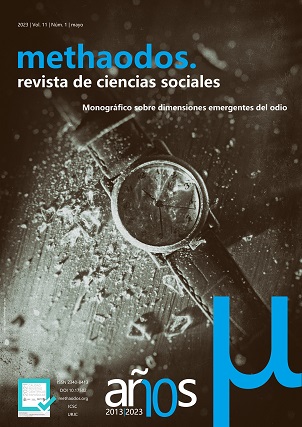Psychosocial Magnetism: the power of social networks to bring people together
Main Article Content
Abstract
Social networks have become one of the main channels of social convergence, triggering social and political actions. This article aims to understand and discuss the aggregation of users through social networks, through algorithms, based on themes, ideologies, preferences, ethnicities, in addition to crossing a series of metadata to induce behaviors, which the authors call Magnetism Psychosocial. Based on exploratory research and the use of a non-systematic literature review and bibliographical research, the various factors that allow the understanding of this phenomenon from a political point of view are sought. Among the results, the ability of algorithms to determine content offered to users stands out, as one of the means of manipulating electoral and social processes around the world. Corroborating this are studies that demonstrate the ability of emotions to be transmitted through social networks and the work developed by Meta to seek to understand the emotional behavior of each individual, in order to offer content that encourages staying connected for longer. Thus, it is conceptualized that Psychosocial Magnetism is translated by the influence of algorithms in exercising the power to connect people through their feelings, interests, preferences, and physical, social and emotional characteristics. However, there is a need to expand studies and possible barriers to these devices.
Downloads
Article Details

This work is licensed under a Creative Commons Attribution-NonCommercial 4.0 International License.
References
Ackland, R., e Gwynn, K. (2020). Truth and the dynamics of news diffusion on twitter. Em The psychology of fake news (pp. 27-46). Routledge.
Arias, J. (2019, 01 de outubro). O ódio de Trump contra a imprensa contagiou o País. El Pais. Disponível em https://bit.ly/3MsVA3I
Bakshy, E., Messing, S., e Adamic, L. A. (2015). Political science. Exposure to ideologically diverse news and opinion on Facebook. Science, 348. 10.1126. https://doi.org/10.1126/science.aaa1160
Cervo, A. L., Bervian, P. A. e Da Silva, R. (2007). Metodologia Científica. [6ª ed.] Pearson Prentice Hall.
Filho, C. M. (2019). As fake news e a nova ordem (des)informativa na era da pós-verdade. Imprensa da Universidade de Coimbra. http://doi.org/10.14195/978-989-26-1778-7
Freud, S. (2010). Psicologia das Massas e análise do Eu e outros textos, obras completas, Vol.15. Companhia das Letras.
Gil, A. C. (2021). Como elaborar projetos de pesquisas. [6.ª ed.] São Paulo: Atlas, 2021.
Gil, A. C. (2008). Métodos e Técnicas de Pesquisa Social. Atlas.
Greifeneder, R. (Ed.), Jaffe, M., Newman, E. J., Schwarx, N. (2021) The Psychology of Fake News - Accepting, Sharing and Correcting Misinformation. Routledge Taylor e Francis Group. https://doi.org/10.4324/9780429295379
OEA Organização dos Estados Americanos. (2019) Missão de Observação Eleitoral - Eleições Gerais Brasil. Disponível em https://bit.ly/3zMVlso
Harari, Y. N. (2018). 21 lições para o século 21. Companhia das Letras.
Harvard Berkman Klein Center for Internet & Society. (2021). Harvard University’s Berkman Klein Center for Internet & Society to launch a three-year multidisciplinary Institute to “reboot social media”. Disponível em https://bit.ly/3mg28rx
Kaufman, D., e Santaela, L. (2020) O papel dos algoritmos de inteligência artificial nas redes sociais. Revista FAMECOS, 27, e34074, 1-10. https://doi.org/10.15448/1980-3729.2020.1.34074
Kramer, A. D., Guillory, J. E.; e Hancock, J. (2014). Experimental evidence of massive-scale emotional contagion through social networks. Proceedings of the National Academy of Sciences of the United States of America, 111(29), 10779. https://doi.org/10.1073/pnas.1412583111
Le Bon, G. (1980). Psicologia das Multidões. Coleção Pensadores, Edições Roger Delraux.
Machado, D. F. (2018). Mediações algorítmicas: o poder de modulação dos algoritmos do Facebook. Parágrafo, 6(1). Disponível em http://revistaseletronicas.fiamfaam.br/index.php/recicofi/article/view/703
Magnetismo (2015) In: Michaelis Moderno Dicionário Brasileiro da Língua Portuguesa. São Paulo: Melhoramentos, 2015. Disponível em https://bit.ly/2PYIJWf
Marconi, M. de A. e Lakatos, E. M. (2015). Metodologia do Trabalho Científico. [7ª ed.] São Paulo: Atlas.
Monitor Mercantil. (2021, 21 de setembro). Brasil é o terceiro país que mais usa redes sociais no mundo. Monitor Mercantil. Disponível em https://bit.ly/3mm7a5V
Moraes, A. L. C., Farias, V. V. M. (2017). O exercício da cidadania da ágora grega ao site de rede social digital. Extraprensa. https://doi.org/10.11606/extraprensa2017.122629
Munn, L. (2018). Ferocious Logics: Unmaking the Algorithm. Lüneburg. Disponível em https://bit.ly/3L2ECrP
Pariser, E. (2011). The filter Bubble - What the Internet is Hiding from you. The Penguim Press.
Piaia, V., Alves, M. (2020). Abrindo a caixa preta: análise exploratória da rede bolsonarista no WhatsApp. Intercom – RBCC, 43(3), 135-154. https://doi.org/10.1590/1809-5844202037
PontodeAcesso. (2020). Salvador, 14(1). Disponível em https://bit.ly/3GsJV0L
Psicossocial. (2015). In: Michaelis Moderno Dicionário Brasileiro da Língua Portuguesa. São Paulo: Melhoramentos, 2015. Disponível em https://bit.ly/2PYIJWf
Richterich, A. (2018). The Big data Agenda. University of Westminster Press. Disponível em https://bit.ly/3ofWYN2
Santos, G. (2020). Redes sociais, desinformação e regulação do processo eleitoral: um estudo baseado na experiência eleitoral brasileira de 2018. Revista de Investigações Constitucionais, 7(2) https://doi.org/10.5380/rinc.v7i2.71057
Siebert, S; e Pereira, I. (2020). A pós-verdade como acontecimento discursivo. Linguagem em (Dis)curso – LemD, Tubarão, SC, 20(2). https://doi.org/10.1590/1982-4017/200201-00-00
Zimerman, D., e Osório, L. C. (1997). Como trabalhamos com Grupos. Porto Alegre: Artes Médicas.

